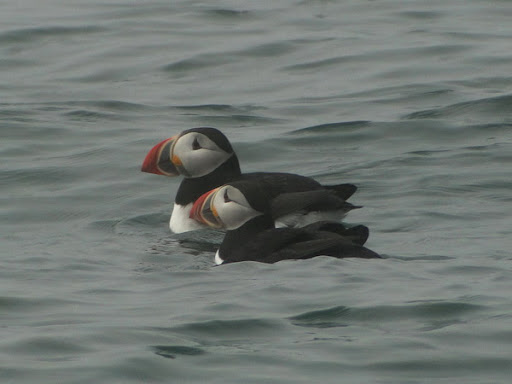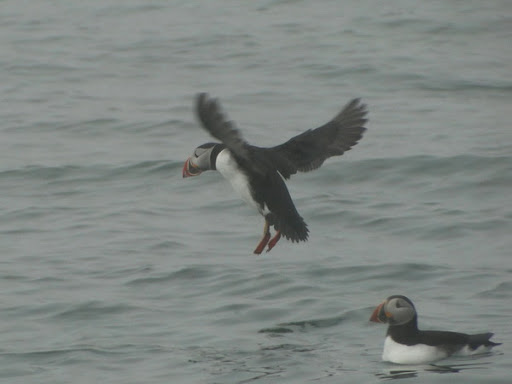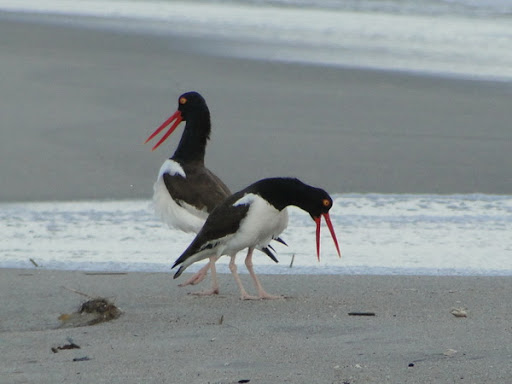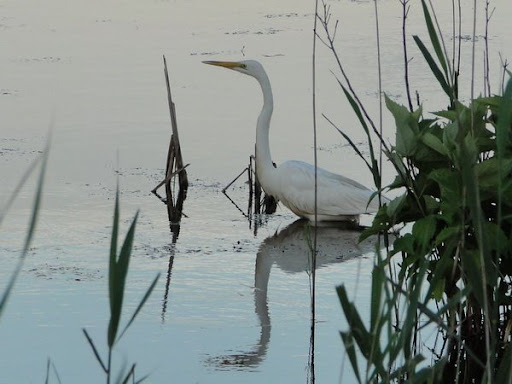Last week’s column about not using “cute” when describing birds generated (via e-mail and blog comments) some vigorous defense of cute, cute birds on the one hand, and on the other hand, several nominations for additional words or phrasesthat should be voted off the planet: nice, amazing, awesome, look (as in “Look,” said the politician), and “to tell the truth,” (What?! Do you lie most of the time?) This week I continue the subject by contrasting a “not cute” bird and a “cute” bird.
Last week in Montague, Massachusetts, I saw a new life bird. A Henslow’s Sparrow was singing atop a grassy stalk in a weedy field. Henslow’s Sparrow is like most sparrows, a little brown job, a nondescript bird. It is small and spends most of its time hiding deep in the grassy habitat it loves. It is seldom seen.
Principally a bird of the tall grass prairies, its range extends into western New York and Central Pennsylvania. Only rarely does it make its way into New England. It has not been reported in Massachusetts for many years.
Therefore, when it showed up in New England, its presence brought birders flocking. This particular individual, probably carried off course by our strange weather patterns this spring, was singing vigorously in the hope of attracting a mate. Probably a forlorn hope. But he clung to the grass stem and sang on and on.
 For the birders, it was essential that he kept singing. He was in the middle of a large field and could only be seen half-way decently with a spotting scope. Even then, the distinguishing physical characteristics could not be distinguished. Too distant. But the enthusiastic song was very distinctive and left no doubt about his identity.
For the birders, it was essential that he kept singing. He was in the middle of a large field and could only be seen half-way decently with a spotting scope. Even then, the distinguishing physical characteristics could not be distinguished. Too distant. But the enthusiastic song was very distinctive and left no doubt about his identity.
You might think, when I say song, of something like the ethereal thrushes, or the robin, or cardinal, or even Song Sparrow. Not at all. The song of the Henslow’s Sparrow is a song that only birders could get excited about. Bent calls the song “unobtrusive.” Peterson describes it as “one of the poorest vocal efforts of any bird.” Kaufman calls it “one of the least impressive of all bird songs, a short tsilick.”
So the Henslow’s Sparrow is small, nondescript, hard to see, and with forgettable vocal abilities. Its redeeming virtue is that it is rare, out-of-range, and a tick on the life list for serious birders.
Kaufman summarizes the conservation status of this sparrow: “Has declined seriously in much of its former range, should be considered threatened. Loss of proper habitat is likely cause; habitat requirements are still not thoroughly understood.”
There is some research that is being done on the Henslow’s Sparrow, as my google results showed. But the research is being done by academics. There is a ho-hum quality about concern for this bird. There is little protest when threatened status under the Endangered Species Act gets denied.
Now let’s contrast the Henslow’s Sparrow with the iconic bird of the Maine coast - the Atlantic Puffin. Here is Forbush’s description of the puffin: “The serio-comic appearance of the little feathered clown is laughable. The bright and handsome colors of its nuptial array are forgotten in contemplation of its peculiar and amazing appearance. Its bright little eyes seem spectacled while its parrot-like bill [is] like a great, highly colored Roman nose ....”
 “Cute” hardly describes the puffin. Endearing, funny, adorable are words that come to mind. In the tourist oriented communities along the Maine coast you will find puffin t-shirts, boxer shorts, pajamas, and sweat-shirts. You will find puffin mugs, puffin postcards and greeting cards, puffin framed photos, puffin carvings and all other manner of puffin related paraphernalia.
“Cute” hardly describes the puffin. Endearing, funny, adorable are words that come to mind. In the tourist oriented communities along the Maine coast you will find puffin t-shirts, boxer shorts, pajamas, and sweat-shirts. You will find puffin mugs, puffin postcards and greeting cards, puffin framed photos, puffin carvings and all other manner of puffin related paraphernalia.
Here’s the irony: the Atlantic Puffin is almost never seen from the shore. It nests on off shore islands, then disappears somewhere into the North Atlantic. To see the puffin, you have to take a puffin watching boat tour.
In the 1920s when Forbush wrote, Machias Seal Island off the northern Maine coast was the puffin’s “nearest real refuge and breeding-place,” where it was making “its last stand near our shores.”
Kaufman summarizes the puffin’s conservation status: “Major declines during 19th century were due to overharvesting of eggs and adults. During 20th century, has continued to decrease at southern end of breeding range in both North America and Europe. Vulnerable to introduction of predators (such as rats) to nesting islands. Since the 1980s, an ambitious project to reintroduce puffins on former nesting islands off Maine has had some success.”
 Ambitious indeed! The Puffin Project has the mission of “developing techniques for restoring seabirds to historic ranges and encouraging the protection and appreciation of seabirds worldwide.” Through efforts of the Puffin Project, several hundred puffin pairs now nest on southern Maine islands, along with colonies of terns and other seabirds. The techniques employed have been replicated in reintroduction programs around the world. The project has a research staff, enlists many volunteers, maintains a visitors’ center, and publishes a glossy annual newsletter.
Ambitious indeed! The Puffin Project has the mission of “developing techniques for restoring seabirds to historic ranges and encouraging the protection and appreciation of seabirds worldwide.” Through efforts of the Puffin Project, several hundred puffin pairs now nest on southern Maine islands, along with colonies of terns and other seabirds. The techniques employed have been replicated in reintroduction programs around the world. The project has a research staff, enlists many volunteers, maintains a visitors’ center, and publishes a glossy annual newsletter.
So what my beef? NONE whatsoever! If it were not for the cute, cute puffin, any number of seabirds (most of which are black, white, gray, and brown, and seldom seen by anybody locked on land) would be silently slipping into extinction.
But how does all this relate to calling some birds, “cute?” Frankly, I’m not sure. In some way it seems that when I make some bird “cute,” I am also making a value judgment - that what is appealing to me in its aesthetics, or the warm fuzzies that it gives me, is inherently more important than what does not do that.
 In a previous generation, hawks were slaughtered on sight because they preyed on “good” birds (and the occasional farm chicken). Crows ate corn, and Bobolinks ate rice - Bang! Bang! In a big attitudinal step forward, the adorably cute puffin now inspires now grants and donations for research and restoration.
In a previous generation, hawks were slaughtered on sight because they preyed on “good” birds (and the occasional farm chicken). Crows ate corn, and Bobolinks ate rice - Bang! Bang! In a big attitudinal step forward, the adorably cute puffin now inspires now grants and donations for research and restoration.
But is the puffin more important than a sparrow that is seldom seen and has a poor excuse for a song? Both are a part of the exquisite variety in creation. Both give evidence to the unlimited imagination of whoever, whatever, or however you may term the mystery behind it all.
Even that poor excuse for a song, “tsilick,” has an essence that says, “Look at the astounding variety in creation!”
Painting of Henslow’s Sparrow is by John James Audubon, which he called Henslow’s Bunting.
Kenn Kaufman quotes are from “Lives of North American Birds,” 1996. Bent and Peterson quotes are from Bent, “Life Histories,” Dover edition, 1968. Forbush quotes are from Forbush & Mays, “American Birds,” 1953.
Post of "Tailfeathers," Brattleboro Reformer, July 10, 2009.
 ... and the bird obligingly scratched the itch of many ...
... and the bird obligingly scratched the itch of many ... The Least Terns were busy over the Conservancy as they hunted food for their hungry young.
The Least Terns were busy over the Conservancy as they hunted food for their hungry young. ... and they were still as aggressive toward intruders as they were a month ago - quite unhappy with beach strollers like me ...
... and they were still as aggressive toward intruders as they were a month ago - quite unhappy with beach strollers like me ...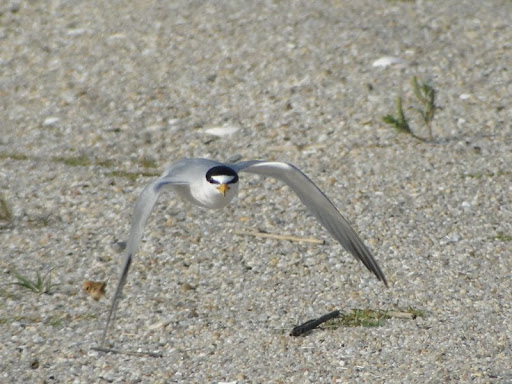 And for just a sampling of other feathered friends ... beginning with the Great Egret (always a favorite of mine, as readers know) ...
And for just a sampling of other feathered friends ... beginning with the Great Egret (always a favorite of mine, as readers know) ... Many, many Mute Swans have nearly grown young and were moving about (these are not young) ...
Many, many Mute Swans have nearly grown young and were moving about (these are not young) ... In the nests at the State Park, Purple Martins had demanding young (redundant, I know, since the young of all are demanding, even cute grandkids) ...
In the nests at the State Park, Purple Martins had demanding young (redundant, I know, since the young of all are demanding, even cute grandkids) ... ... and at least one Mallard had a young brood (maybe a second on the year). Like all young, especially cute when they finally settle down for the night.
... and at least one Mallard had a young brood (maybe a second on the year). Like all young, especially cute when they finally settle down for the night. Good birding!
Good birding!































